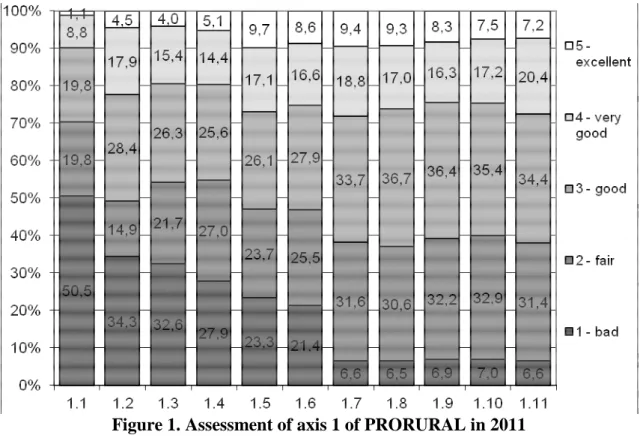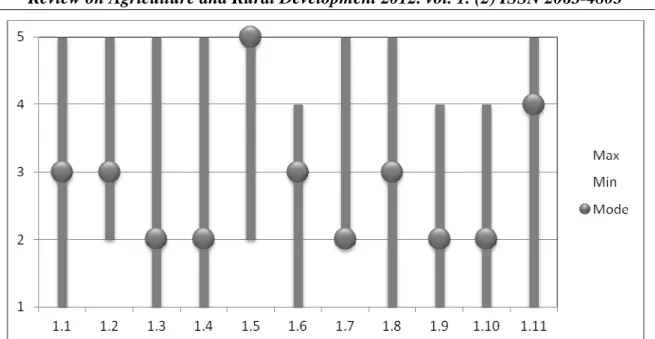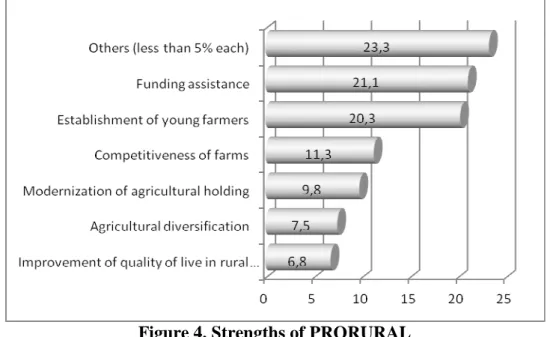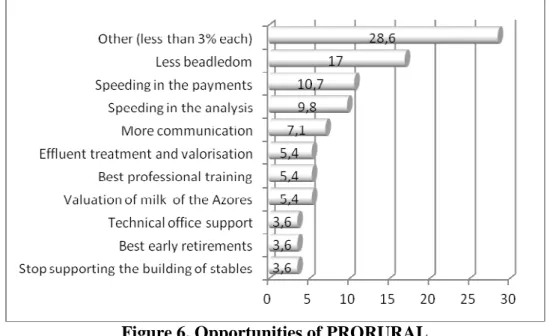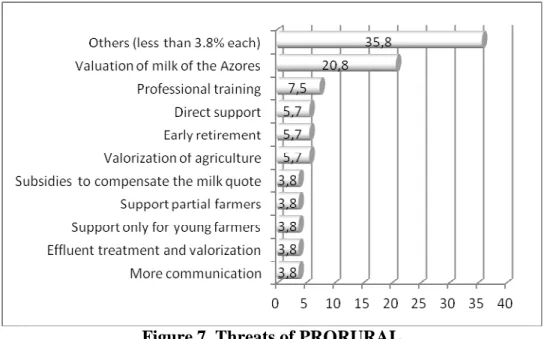REVIEW ON AGRICULTURE
AND RURAL DEVELOPMENT
SCIENTIFIC JOURNAL OF THE UNIVERSITY OF SZEGED, FACULTY OF AGRICULTURE
Volume 1. (2)
Hódmezővásárhely
Published by: University of Szeged Faculty of Agriculture 6800 Hódmezővásárhely Andrássy Street 15. Responsible publisher:
Károly Bodnár dean
Executive editor:
József Horváth vice-dean for science affairs
The members of the Editorial Board:
Károly Bodnár István Majzinger Tamás Monostori Judit Péter Szűcs
Lajos Tanács
The members of the Scientific Council: David Arney, Estonian University of Life
Sciences, Estonia
Erika Bodnár Skobrák, University of Szeged Ioan Csosz, University of Agriculture and
Veterinary Medicine of the Banat, Romania
Levente Komarek, University of Szeged István Kristó, University of Szeged, Hungary Ilona Edit Mári, University of Szeged Edit Mikó Jónás, University of Szeged
Margherita Mori, University of L’Aquila, Italy
Sebahat Ozman-Sullivan, Ondokuz Mayis
University, Turkey
Paul Pîrşan, University of Agriculture and
Veterinary Medicine of the Banat Romania
Emiliana Leonilde Diniz Gil Soares da Silva,
University of Azores, Portugal
Tímea Süli-Zakar, University of Szeged,
Hungary
Ryszard Zamorski, University of Technology
and Life Sciences in Bydgoszcz, Poland
ISSN 2063-4803
Printed in 300 copies Typography: Planet Corp Ltd.
CONTENTS
Emiliana Leonilde Diniz Gil Soares da Silva – Armando Brito Mendes:
Prorural: Program assessment in an involved actor’s perspective 493 Bodnár, K.: The examination of the aspects of higher education institution selection
in a group of BSc. course students 501
Szabó, B. – Posta, L.: Natural, Social and Economic examinations of ecovillages
focusing on a certain example 510
Komarek, L.: The features of the macro level absolute concentration
of Hungarian industry 519
Lantos, F. – Monostori, T.: A plant breeding approach to eliminate the development of
calcium deficiency symptoms in sweet pepper growing 525
Lantos, F. – Horváth, T. – Rózsás, A.: The effect of Clamydomonas and Asterococcus green algae species on soil status conservation in sweet pepper growing 530 Bodnárné Skobrák, E. – Bodnár, K.: The main chemical composition parameters
of pork (review) 534
Gráff, M. – Benk, Á.: Live weight change examinations of indigenous speckled hens
on a farm in Hódmezővásárhely 541
Mikóné Jónás, E.: The body condition scoring system of dairy cows (review)
548 Barta, T. – Majzinger, I. – Gundel J.: The feed composition of roe deer
(Capreolus capreolus) on plain habitats 556
Sallai, L.: The effect of organic residues’ co-fermentation on biogas potential
of different sized economical units 563
Horváth, S. N.: Science parks in city regions after the global economic crisis
569 Bodnár, G.: Role of social capital in rural spaces
577 Galgóczi-Deutsch, M.: A manifestation of language policy in Hungary – the bilingual
education of minority language speakers 583
Gálné Horváth, I.: Transformation hobby gardens residential area
Review on Agriculture and Rural Development 2012. vol. 1. (2) ISSN 2063-4803 PRORURAL: PROGRAM ASSESSMENT IN AN INVOLVED ACTOR’S
PERSPECTIVE
EMILIANA LEONILDE DINIZ GIL SOARES DA SILVA,ARMANDO BRITO MENDES CEEAplA - Universidade dos Açores
Rua Capitão João D' Ávila
9700-042 - São Pedro, Angra do Heroísmo Açores, Portugal
emiliana@uac.pt; amendes@uac.pt
ABSTRACT
PRORURAL- Azores Rural Development Plan - for 2007 to 2013, is the European Union rural development policy adjusted to the Azores Region and it is supported by European Agricultural Fund for Rural Development. The PRORURAL was approved by Commission Decision C (2007) 6162, on the 4th of December 2007. The PRORURAL has four center lines: 1) improving competitiveness of the agricultural and forestry sectors; 2) improvement of the environment and rural landscape; 3) quality of life in rural areas and diversification of economy; and 4) operation of LAGs, Acquisition of skills and entertainment in rural areas.
The financial implementation rate was 34% and its approval rate was about 60% as regards to plan´s total allocation. This higher performance achieved in the material and financial execution was the result of the concerted effort between all entities in charges of the programmer’s management and the commitment and initiative of the beneficiaries despite the economic crises period.
The objective of this research is the assessment of the PRORURAL in an engaged actor’s perspective. For that, it was established an expert panel, constituted mainly by farmers. A questionnaire was made and a Strengths, Weaknesses/Limitations, Opportunities, and Threats –SWOT- matrix is presented.
Keywords: Assessment, Azores, Rural Plan, PRORURAL, SWOT analysis.
INTRODUCTION
The main objective of this paper is the assessment of PRORURAL plan according to the farmers’ point of view.
The PRORURAL was approved by Commission Decision C (2007) 6162, on the 4th of December 2007 and is a part of second pillar of the Common Agricultural Policy (CAP). The PRORURAL has four center lines or axis: 1) improving competitiveness of the agricultural and forestry sectors; 2) improvement of the environment and rural landscape; 3) quality of life in rural areas and diversification of economy; and 4) operation of LAGs, acquisition of skills and entertainment in rural areas.
The improving competitiveness of the agricultural and forestry sectors (axis 1) has the following tools:
1.1. Professional training and information actions. 1.2. Establishment of young farmers.
1.3. Early retirement.
1.4. Management and advising services (agriculture and forestry). 1.5. Modernization of agricultural holding.
1.6. Improvement of the economic value of forest.
1.7. Adding the value of agriculture and forestry product. 1.8. Cooperation for the promotion of innovation.
1.9. Creation and development of new financial instruments. 1.10. Natural disasters.
The instruments of the improvement of the environment and rural landscape (axis 2), are: 2.1. Maintaining of agricultural activity in Less Favored Areas.
2.2. Agri-environment payments and Natura 2000. 2.3. Support to non-productive investments. 2.4. Management of forestry areas.
The tools of quality of life in rural areas and diversification of the economy (axis 3) are: 3.1. Diversification of the economy and creating employment in rural areas.
3.2. Improvement of quality of life in rural areas. 3.3. Training and information.
The tools of Leader approach (axis 4) are: 4.1. Execution of local development strategies. 4.2. Cooperation LEADER.
4.3. Operating of the LAG´s, acquisition of skills and entertainment in rural areas. Table 1. Number of projects in PRORURAL, in the center lines 1 to 4
Center lines: Nº %
1. Improving competiveness of the agricultural and forestry sectors 56 70 2. Improving of the environment and rural landscape 1 1.25 3. Quality of life in rural areas and diversification of the Rural
economy
22 27.5
4. Leader approach 1 1.25
Total 80 100
Source: (PRORURAL, 2011)
The most demanded measures were in the center line 1, improving competiveness of the agricultural and forestry sectors (70%) and in the center line 3, quality of life in rural areas and diversification of the rural economy (27.5%) (Table 1). The center lines 2, improving of the environment and rural landscape and 4, Leader approach, only had one project (1.25% each one).
Table 2. Number of projects in PRORURAL, in the center lines 1
Center line 1: Nº %
1.2. Establishment of young farmers and 1.5. Modernization of agricultural holdings.
29 51.8
1.3. Early retirement 4 7.1
1.6. Improvement of the economic value of forest 5 8.9 1.7. Adding the value of agriculture and forestry product 9 16.1 1.11. Improvement and development of infrastructure 9 16.1
Total 56 100
Source: (PRORURAL, 2011)
Both tools, Establishment of young farmers (1.2.) and Modernization of agricultural holdings (1.5.), represent more than one half (51.8%) of the investments in the center line 1 (Table 2). The adding the value of agriculture and forestry product (1.7.) and the Improvement and development of infrastructure (1.11.) were the second most important measures (16.1% each one). The less important measure in axis 1 was Early retirement (1.3.) (7.1%)
Review on Agriculture and Rural Development 2012. vol. 1. (2) ISSN 2063-4803 Table 3. Number of projects in PRORURAL, in the center line 3
Center line 3: Nº %
3.1 Diversification of the economy and creating employment in rural areas
12 54.5 3.2. Improvement of quality of life in rural areas 10 45.5
Total 22 100
Source: (PRORURAL, 2011)
The Diversification of the economy and creating employment in rural areas (3.1) were an investment option for 54.5% of total investment of center line 3 and the improvement of quality of life in rural areas (3.2.) were 45.5% of the total number of projects (Table 3).
MATERIAL AND METHODOLOGY
The assessment of PRORURAL is made by a panel of 44 farmers involved in the program. It was conceived and applied a questionnaire to the panel, inquiring their personal vision of the assessment of PRORURAL program.
The questionnaire was divided in three parts: the first one had four questions which inquired four alternatives about their opinion of the strengths, weakness, the threats and opportunities of the PRORURAL program. This part had allowed led to the SWOT matrix. The second part was the axis tools assessment. It was used an ordinal scale with 5 points: 1 (bad); 2 (fair); 3 (good); 4 (very good) and 5 (excellent). The answers were analyzed using statistics, such as, maximum and minimum value, average and mode with the objective of identifying the best and worst tools in the axis. Finally, the third part had additional information, such us, year of birth, profession, level of education, and place of living; used to characterize the social profile.
The SWOT matrix is a tool very much used in the assessment of programs (MENON ET AL., 1999). The SWOT analysis is a strategic planning method used to evaluate the internal environment: Strengths, Weaknesses/Limitations and also the external environment: Opportunities, and Threats involved in a project or in a business venture. It involves specifying the objective of the business venture or project and identifying the internal and external factors that are favorable and unfavorable to achieve that objective (TEIXEIRA, 2005 AND 2011). The SWOT matrix will allow achievable goals or objectives to be set for the
organization. The strengths are the characteristics of the business or project team that give it an advantage over others. The weaknesses are characteristics that place the team at a disadvantage (limitations) relative to others. The opportunities are external chances to improve performance (greater profits) in the environment. Finally, the threats are external elements in the environment that could cause trouble for the business or project.
The major importance of SWOT matrix is to point the strenghts and weak points, to realize the opportunities and threats and to express a strategic direction. The SWOT analysis may be used in any decision-making situation when a desired end-state (objective) has been defined. Examples include: non-profit organizations, governmental units, and individuals. SWOT analysis may also be used in pre-crisis planning and preventive crisis management. It has also being used in creating a recommendation during a viability study/survey.
In agriculture field the SWOT matrix is useful as a data qualitative analysis, as it can be find in some researches (TIBÉRIO ET AL., 2008) but also in professional training (VINHA AND
RESULTS
The survey comprised a total of 44 valid questionnaires. The questionnaires were from Terceira (59%) and S. Miguel (41%) islands. About 90.9% were male and 9.1% were female. The age average of people inquired was 38 years old (21 was the youngest and 58 was de elder). The average years of education was 10 and ranges from 4 to 19 (master degree). The co-financing contribution of European and Azorean programs in average were about 65.6% (the maximum value were 81.9% and the minimum value was 54.5%).
In Figure 1 we can find a graphic with Axis 1, the improving competitiveness of the agricultural and forestry sectors, of PRORURAL. The best results were the following measures: 1.8. Cooperation for the innovation promotion (93.5% of each positive answer, which means equal or upper than fair); 1.7. Adding the value of agriculture and forestry product and 1.11. Improvement and development of infrastructure (93.4% of each answer was equal or upper then fair); 1.9. Creation and development of new financial instruments (93.1% of each answer was upper equal or then fair); and 1.10. Natural disasters (93% of each answer was equal or upper then fair). The best Excellent scores (5) were obtained by 1.5. Modernization of agricultural holding (9.7%) and 1.7. Adding the value of agriculture and forestry product (9.4%); and 1.8. Cooperation for the promotion of innovation (9.3%).
Figure 1. Assessment of axis 1 of PRORURAL in 2011
In the central line 1, the worst results were (Figure 1): 1.1. Professional training and information actions (about of one half, 50.5% had answered badly), 1.2. Establishment of young farmers, (34.3% of bad score), 1.3. Early retirement (32.6% respondents had chosen a score ’bad’), and the tool, 1.4. Management and advising services - agriculture and forestry (27.9% respondents had scored ’bad’).
Review on Agriculture and Rural Development 2012. vol. 1. (2) ISSN 2063-4803
Figure 2. The maximum, minimum and mode scores of axis 1 of PRORURAL The tools with the maximum grade (5) are: all tools in the axis 1, except 1.6. Improvement of the economic value of forest, 1.9. Creation and development of new financial instruments, and 1.10. Natural disasters (Figure 2).
With the minimum grade (1) we can find on Figure 2: all tools in the axis 1, except 1.2. Establishment of young farmers, 1.5. Modernization of agricultural holding, and 1.7. Adding the value of agriculture and forestry product.
Figure 3. The average score of axis 1 of PRORURAL
The best average (3.7) was found in toll 1.5. Modernization of agricultural holding and the second best is the tool 1.11. Improvement and development of infrastructure (3.4). The worst average (2.0) is relative to tolls 1.3. Early retirement and 1.6. Improvement of the economic
value of forest. The best mode (5) was 1.5 Modernization of agricultural holding (Figures 2
and 3).
The SWOT matrix
The most important strengths (Figure 4) of PRORURAL according to our research were: funding assistance (21.1% of respondents), establishment of young farmers (20.3%), competitiveness of farms (11.3%), modernization of agricultural holding (7.5%), agricultural diversification (7.5%) and improvement of quality of live in rural areas (6.8%). The other strengths mentioned in the questionnaire were: online application, animal welfare, communication, early retirement, environmental pressing, online application, self-employment; professional training and pasture renovation.
Figure 4. Strengths of PRORURAL
The most important weakness of PRORURAL was (Figure 5): Beadledom (27.8% of respondents), Delays in project analysis (30.4%) and Delays in the payments (10.4%). The other weakness pointed were: No innovation, Difficulties in the first application, Degradation of rural landscape, Difficulties in bank credit, SIAFAGRI do not work well, Complexity of European rules; the Head limit eligible criteria for each tool; Dependency of own capital; and Absence of poultry support.
Review on Agriculture and Rural Development 2012. vol. 1. (2) ISSN 2063-4803
Figure 5. Weaknesses of PRORURAL
Although the answers about the most important opportunities of PRORURAL were very diverse (Figure 6) the ones most relevant were: Less beadledom (mentioned by 17.0% of respondents), Speeding in the payments (10.7%), Speeding in the analysis (9.8%), More communication (7.1%), Best professional training and Effluent treatment and valorisation (5.4% each one). But, the top scores are: Stop supporting the building of stables, Early retirement and Technical office support (3.6% each one).
Figure 6. Opportunities of PRORURAL
The range of answers about threats were enormous, but it is possible to assort the main threats
(Figure 7), in the following groups: Promotion the Azorean milk (20.8%); Professional
training (7.5%); Valorization of agriculture, Early retirement and Direct support (5.7% each one); More communication, Effluent treatment and valorization, Support only for young farmers, Support partial farmers and Subsidies to compensate the milk quote (3.8% each one).
Figure 7. Threats of PRORURAL
CONCLUSIONS
We can conclude that the interviewees belief that the strengths of PRORURAL were mainly the funding assistance, establishment of young farmer and modernization of agricultural holding. The weaknesses recognized were mainly beadledom and delays in the project analysis and in payments. The threats were valuation of milk production, technical office support and professional training. The opportunities were less beadledom, speeding in the project analysis and in the payments.
According to these results it will be recommended that we need many more flexibility along with the investment project, conception and analysis. We also need to develop some tools, such as professional training and conceive the innovation and the valorization of Azorean products as an opportunity for marketing.
REFERENCES
MENON, A.; BHARADWAJ, S. G.; ADIDAM, P. T.; EDISON, S. W. (1999): Antecedents and
Consequences of Marketing Strategy Making", Journal of Marketing (American Marketing Association) 63 (2): 18–40 (doi:10.2307/1251943).
PRORURAL+ (2011), Direção Regional dos Assuntos Comunitários, Secretaria Regional de
Agricultura e Pescas, Região Autónoma dos Açores.
TEIXEIRA,S.(2005): Gestão das Organizações, 2 ed., Mc-Graw-Hill. TEIXEIRA,S. (2011): Gestão Estratégica, Escolar Editora.
TIBÉRIO,L.;CRISTÓVÃO,A.;ABREU,S. (2008): Microproduções agrícolas e desenvolvimento
sustentável em regiões periféricas, Revista Portuguesa de Estudos Regionais, Nº 17, 5-24. VINHA, E.; LIMA-SANTOS, N. (2010): Adaptação da Matriz SWOT à avaliação da Formação Profissional, Actas do VII Simpósio Nacional de Investigação em Psicologia, Universidade do Minho, Portugal.

